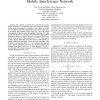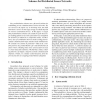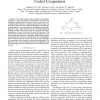357 search results - page 61 / 72 » Channel Diversity in Random Wireless Networks |
ISCC
2003
IEEE
14 years 25 days ago
2003
IEEE
— We consider a network of n sender/receiver pairs, placed randomly in a region of unit area. Network capacity, or maximum throughput, is defined as the highest rate that can be...
JSAC
2008
13 years 7 months ago
2008
Although there are many MAC protocols that have been proposed for terrestrial wireless networks with a wide variety of aspects, these protocols cannot be applied directly in underw...
PERCOM
2006
ACM
14 years 7 months ago
2006
ACM
Key predistribution schemes are a favoured solution for establishing secure communication in sensor networks. Often viewed as the safest way to bootstrap trust, the main drawback ...
GLOBECOM
2007
IEEE
14 years 1 months ago
2007
IEEE
— This paper explores relay selection and selection diversity for coded cooperation in wireless sensor networks, with complexity constraints for the sensor nodes. In previous wor...
ICC
2009
IEEE
14 years 2 months ago
2009
IEEE
— In most wireless relay networks, the source and relay nodes transmit successively via fixed time division (FTD) and each relay forwards a packet immediately upon receiving. In...



